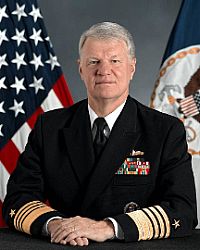Gary Roughead: Difference between revisions
imported>Howard C. Berkowitz (New page: Admiral '''Gary Roughead''' became the 29th Chief of Naval Operations on 29 September 2007, the culmination of a career starting with 1973 graduation of the United States Naval Academy. H...) |
mNo edit summary |
||
| (7 intermediate revisions by 3 users not shown) | |||
| Line 1: | Line 1: | ||
Admiral '''Gary Roughead''' became the 29th Chief of Naval Operations | {{PropDel}}<br><br>{{subpages}} | ||
Admiral '''Gary Roughead''' became the 29th Chief of Naval Operations, the senior professional officer of the United States Navy, on 29 September 2007. He has commanded six operational units, both ships and larger sea commands. | |||
[[Image:CNO Gary Roughead.jpg|left|thumb|Adm. Gary Roughead, Chief of Naval Operations]] | [[Image:CNO Gary Roughead.jpg|left|thumb|Adm. Gary Roughead, Chief of Naval Operations]] | ||
A surface warfare specialist, he was the first officer to command both types of ships with the [[AEGIS battle management system]], the [[Burke-class]] [[destroyer]] ''USS Barry'' and the [[Ticonderoga-class]] [[cruiser]] ''USS Port Royal''. He has also commanded the ''USS George Washington'' carrier battle group and the U.S. Second Fleet/NATO Striking Fleet Atlantic. He also had the administrative job of commanding the Pacific Fleet. | |||
Recently, he was credited with cutting a Gordian knot in deployment of the experimental [[Zumwalt-class]] destroyers, billion-dollar large ships whose production was capped at three, in part because they lacked an area air defense system. The radar and electronics to give them such, planned for other classes, would not be ready for a year. Admiral Roughead ordered that the Zumwalt production be slowed for a year and a slight redesign made so they could accept the needed radar. | |||
==Earlier career== | |||
He is a 1973 graduate of the U.S. Naval Academy, who subsequently was its Commandant. | |||
A surface warfare specialist, he was the first officer to command both types of ships with the [[AEGIS battle management system]], the [[Burke-class]] [[destroyer]] ''USS Barry'' and the [[Ticonderoga-class]] [[cruiser]] ''[[USS Port Royal (CG-73)]]''. He has also commanded the ''USS George Washington'' carrier battle group and the U.S. Second Fleet/NATO Striking Fleet Atlantic. He also had the administrative job of commanding the Pacific Fleet. | |||
His Naval shore assignments included Commandant of the [[United States Naval Academy]] and Chief of Legislative Affairs. | His Naval shore assignments included Commandant of the [[United States Naval Academy]] and Chief of Legislative Affairs. | ||
In joint operational commands, he was Deputy Commander, [[ | In joint operational commands, he was Deputy Commander, U.S. Pacific Command.[[Category:Suggestion Bot Tag]] | ||
Latest revision as of 11:00, 20 August 2024
| This article may be deleted soon. | ||
|---|---|---|
Admiral Gary Roughead became the 29th Chief of Naval Operations, the senior professional officer of the United States Navy, on 29 September 2007. He has commanded six operational units, both ships and larger sea commands. Recently, he was credited with cutting a Gordian knot in deployment of the experimental Zumwalt-class destroyers, billion-dollar large ships whose production was capped at three, in part because they lacked an area air defense system. The radar and electronics to give them such, planned for other classes, would not be ready for a year. Admiral Roughead ordered that the Zumwalt production be slowed for a year and a slight redesign made so they could accept the needed radar. Earlier careerHe is a 1973 graduate of the U.S. Naval Academy, who subsequently was its Commandant. A surface warfare specialist, he was the first officer to command both types of ships with the AEGIS battle management system, the Burke-class destroyer USS Barry and the Ticonderoga-class cruiser USS Port Royal (CG-73). He has also commanded the USS George Washington carrier battle group and the U.S. Second Fleet/NATO Striking Fleet Atlantic. He also had the administrative job of commanding the Pacific Fleet. His Naval shore assignments included Commandant of the United States Naval Academy and Chief of Legislative Affairs. In joint operational commands, he was Deputy Commander, U.S. Pacific Command. |
||
